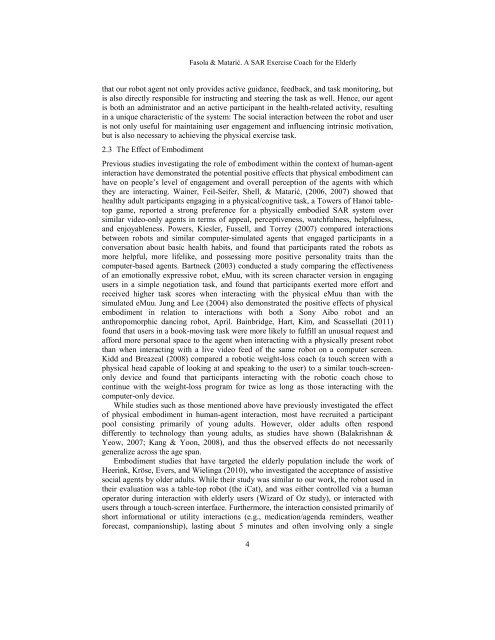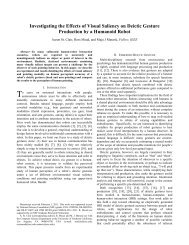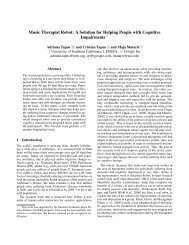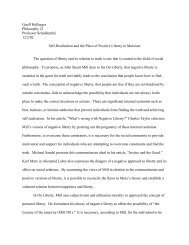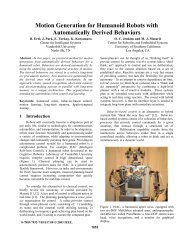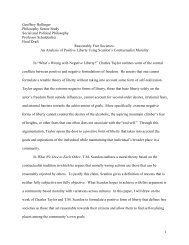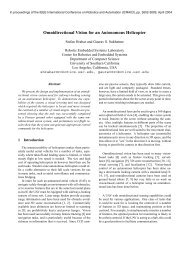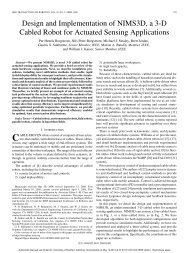A Socially Assistive Robot Exercise Coach for the Elderly
A Socially Assistive Robot Exercise Coach for the Elderly
A Socially Assistive Robot Exercise Coach for the Elderly
You also want an ePaper? Increase the reach of your titles
YUMPU automatically turns print PDFs into web optimized ePapers that Google loves.
Fasola & Matarić. A SAR <strong>Exercise</strong> <strong>Coach</strong> <strong>for</strong> <strong>the</strong> <strong>Elderly</strong>that our robot agent not only provides active guidance, feedback, and task monitoring, butis also directly responsible <strong>for</strong> instructing and steering <strong>the</strong> task as well. Hence, our agentis both an administrator and an active participant in <strong>the</strong> health-related activity, resultingin a unique characteristic of <strong>the</strong> system: The social interaction between <strong>the</strong> robot and useris not only useful <strong>for</strong> maintaining user engagement and influencing intrinsic motivation,but is also necessary to achieving <strong>the</strong> physical exercise task.2.3 The Effect of EmbodimentPrevious studies investigating <strong>the</strong> role of embodiment within <strong>the</strong> context of human-agentinteraction have demonstrated <strong>the</strong> potential positive effects that physical embodiment canhave on people’s level of engagement and overall perception of <strong>the</strong> agents with which<strong>the</strong>y are interacting. Wainer, Feil-Seifer, Shell, & Matarić, (2006, 2007) showed tha<strong>the</strong>althy adult participants engaging in a physical/cognitive task, a Towers of Hanoi tabletopgame, reported a strong preference <strong>for</strong> a physically embodied SAR system oversimilar video-only agents in terms of appeal, perceptiveness, watchfulness, helpfulness,and enjoyableness. Powers, Kiesler, Fussell, and Torrey (2007) compared interactionsbetween robots and similar computer-simulated agents that engaged participants in aconversation about basic health habits, and found that participants rated <strong>the</strong> robots asmore helpful, more lifelike, and possessing more positive personality traits than <strong>the</strong>computer-based agents. Bartneck (2003) conducted a study comparing <strong>the</strong> effectivenessof an emotionally expressive robot, eMuu, with its screen character version in engagingusers in a simple negotiation task, and found that participants exerted more ef<strong>for</strong>t andreceived higher task scores when interacting with <strong>the</strong> physical eMuu than with <strong>the</strong>simulated eMuu. Jung and Lee (2004) also demonstrated <strong>the</strong> positive effects of physicalembodiment in relation to interactions with both a Sony Aibo robot and ananthropomorphic dancing robot, April. Bainbridge, Hart, Kim, and Scassellati (2011)found that users in a book-moving task were more likely to fulfill an unusual request andaf<strong>for</strong>d more personal space to <strong>the</strong> agent when interacting with a physically present robotthan when interacting with a live video feed of <strong>the</strong> same robot on a computer screen.Kidd and Breazeal (2008) compared a robotic weight-loss coach (a touch screen with aphysical head capable of looking at and speaking to <strong>the</strong> user) to a similar touch-screenonlydevice and found that participants interacting with <strong>the</strong> robotic coach chose tocontinue with <strong>the</strong> weight-loss program <strong>for</strong> twice as long as those interacting with <strong>the</strong>computer-only device.While studies such as those mentioned above have previously investigated <strong>the</strong> effectof physical embodiment in human-agent interaction, most have recruited a participantpool consisting primarily of young adults. However, older adults often responddifferently to technology than young adults, as studies have shown (Balakrishnan &Yeow, 2007; Kang & Yoon, 2008), and thus <strong>the</strong> observed effects do not necessarilygeneralize across <strong>the</strong> age span.Embodiment studies that have targeted <strong>the</strong> elderly population include <strong>the</strong> work ofHeerink, Kröse, Evers, and Wielinga (2010), who investigated <strong>the</strong> acceptance of assistivesocial agents by older adults. While <strong>the</strong>ir study was similar to our work, <strong>the</strong> robot used in<strong>the</strong>ir evaluation was a table-top robot (<strong>the</strong> iCat), and was ei<strong>the</strong>r controlled via a humanoperator during interaction with elderly users (Wizard of Oz study), or interacted withusers through a touch-screen interface. Fur<strong>the</strong>rmore, <strong>the</strong> interaction consisted primarily ofshort in<strong>for</strong>mational or utility interactions (e.g., medication/agenda reminders, wea<strong>the</strong>r<strong>for</strong>ecast, companionship), lasting about 5 minutes and often involving only a single4


